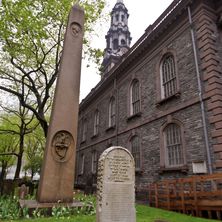

The St. Paul Episcopal Chapel, named after one of the most important Christian missionaries and theologians, Paul the Apostle, is the oldest religious edifice in Manhattan. It was constructed in 18th century out of a bedrock called the Manhattan mica-schist, which can still been found today in several areas in Central Park. The shrine has a high portico and above, in the triangular tympanum of the facade, ensconced in a niche between two oculi, is an oak statue of the patron saint himself.
St. Paul's interior is very simple and bright. The pinkish walls and the light blue arched ceiling express a joyous state of mind and the large windows will never let you forget that you are in a modern metropolis. Essentially, the church is a perfect example of the comfortable, domestic quality of the Protestant Religion, even though officially it is part of the Episcopal Church, which is a member of the worldwide Anglican Communion. The Episcopal Church of the United States is a blend of Protestantism and Catholicism. It does not obey the Pope in Rome, but it venerates the saints. It also has a hierarchy that resembles the Catholic Church, a hierarchy that permits women to hold major positions within the organization. In fact, the current Presiding Bishop of the Episcopal Church of the United States is Katherine Jefferts Schori. She is also the first woman to have become primate in the Anglican Communion. Officially, St. Paul's is just a chapel of the nearby Parish of Trinity Church.
The St. Paul's Chapel's claim to fame came on April 30, 1789 when George Washington worshipped there after being inaugurated as first president of the United States of America. The president continued visiting the church for the next two years until the nation's capital was moved to Philadelphia. His pew has been preserved in the chapel. It is located to the left of the altar, under the painting of the Great Seal of the United States. The church also contains the tomb monument of revolutionary hero General Richard Montgomery, who died in 1775 when the Americans were trying to capture British Quebec. The graveyard behind the church accommodates many tombs from the 18th centuries. The main entrance to the church, in fact, is located on the cemetery side, under the magnificent belfry and spire. At the time of its construction, the St. Paul's spire was no doubt the highest structure in the young city.
The September 11 attacks and the collapse of the Twin Towers, which were located just two hundred meters away from St. Paul's, did not damage the church. Surprisingly, not even a window was shattered. There was just a lot of dirt, ash and smoke everywhere, which did however affect the pipes of the organ. During the one-year recovery period that followed, the church served as a place of rest for the volunteers, fire fighters, policemen and construction workers who were cleaning up the debris in the World Trade Center.
The St. Paul's Chapel is a National Historic Landmark. Not only is it New York's oldest church, it is the city's oldest public building.